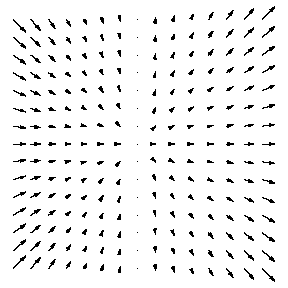Each problem is worth 10 points. Be sure to show all work for full
credit. Please circle all answers and keep your work as legible as possible.
Not responsible for damage due to clogs.
1. Find ![]() ,
where C is a line segment starting at (0,1) and ending at (
,
where C is a line segment starting at (0,1) and ending at (![]() ,-1).
,-1).
2. Compute ![]() along the counterclockwise quarter circle from (1,0) to (0,1).
along the counterclockwise quarter circle from (1,0) to (0,1).
3. Compute ![]() for the path C consisting of the first-quadrant portion of a circle (centered
at the origin) of radius 3 traversed counterclockwise, along with the line
segments from (0,3) to (0,0) and from (0,0) to (3,0).
for the path C consisting of the first-quadrant portion of a circle (centered
at the origin) of radius 3 traversed counterclockwise, along with the line
segments from (0,3) to (0,0) and from (0,0) to (3,0).
4. The Earth constantly radiates heat into space, partly due to internal
cooling and partly due to reflected energy from the Sun. Suppose this heat
is radiated according to the vector field F(x,y,z) = 10xi
+10yj + zk. What is the flux of this vector field through
the surface of the Earth's upper atmosphere, which forms a sphere about
7300 kilometers in radius?
5. When water drains out of a bathtub and swirls down a pipe, the vector
field representing the velocity of the water might be modeled by F(x,y,z)
= -yi + xj - 5k. Suppose the pipe is a cylinder of
radius of 2 cm (centered around the z axis) and has a filter screen shaped
like the plane 2x + 3y + z + 6 = 0 in it. Compute the flux of this vector
field through this surface (assume the surface is oriented positively).
6. Show that for any vector field F(x,y,z) = P(x,y,z)i
+ Q(x,y,z)j + R(x,y,z)k, so long as P, Q, and R have continuous
second-order partial derivatives, div(curl F) = 0. How is the requirement
that the partials be continuous necessary?
7. Buffy is having trouble with conservative vector fields. "Oh my God, I just, like, don't get it. I mean, like, we looked at this one, you know? And I, like, told this guy Biff that I was studying with that it was, like, conserva-whatever 'cause when you, like, draw a half circle going, like, either way around from up at the top to down at the bottom, it's like, totally across the arrow thingys so it's like zero either way, y'know? So I think it's conserva-whatever, but this Biff guy says it's not, but, y'know, he's not very smart, I think maybe, so I dunno, y'know?"
Who's right, Biff or Buffy, and what do you think of her reasoning?

8. Show that in any vector field F(x,y) = P(x,y)i + 0j,
where P has continuous partial derivatives, the line integral through F
along any vertical line segment C will be zero (this is essentially the
portion of the proof of Green's Theorem that I hand-waved in class). [Hint:
If you have trouble figuring how to do it in general, warm up with your
favorite particular vertical line segment and a nice vector field like
F(x,y)
= xyi + 0j, then see if you can generalize.]
9. The parametric equations x = cosh u cos v, y = cosh u sin v, z =
sinh u, represent a hyperboloid of one sheet. Show that the surface area
of such a hyperboloid between the planes z = a and z = b is given by the
integral  .
[Hint: Recall that (sinh x)' = cosh x and (cosh x)' = sinh x.]
.
[Hint: Recall that (sinh x)' = cosh x and (cosh x)' = sinh x.]
10. Stewart gives a simpler formula for flux integrals through a vector
field F = Pi + Qj +Rk when the surface involved
can be expressed in the form z = g(x,y). Show that in this case the general
version we used reduces to ![]() .
.
Extra Credit (5 points possible): How does the flux through the drain
pipe in problem 5 depend on the slope of the plane and the radius of the
pipe? Justify your answers.